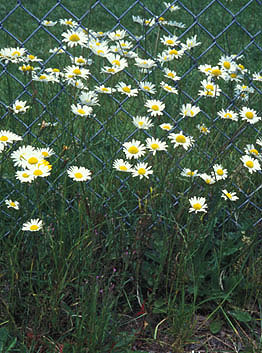
|
| Oxeye Daisy; Leucanthemum vulgare Lam. |
| = Chrysanthemum Leucanthemum L. |
Sunflower Family; COMPOSITÆ (ASTERACEÆ)
|
| Daisies of three kinds are well known. We walk on tiny lawn daisies (Weed of the Month July 1986), we cultivate flower-garden
shasta daisies, and view as wildflowers or weeds the ox-eyes of fields and vacant lots. Oxeye daisy has a host of other names to introduce
it. From its usual habitat: Field Daisy. Compared to lawn daisies: Big Daisy, Great Daisy, or Midsummer Daisy. From its
appearance: Whiteweed, Moon Penny, Bull's-eye Daisy. From its weediness to farmers: Devil's Daisy. It is also known as Herb Margaret in
most European languages. |
| It is the "Love me -- Love me not" daisy; a symbol of innocence. History's greatest plant-breeder, Luther Burbank, labored
15 years crossing Oxeye with other daisies to produce the dazzling white, wonderfully large version he introduced in 1901 under the
now world-famous name shasta. |
| As we all know what daisies look like, let's be brief in description. The plant is a short-lived perennial that grows a foot or
two tall, and from May onwards bears flowers about 2 inches wide (larger ones result from shasta daisy cross-breeding). Smell the
golden center to discover the subtle scent that attracts flies to pollinate the blossoms. The dark green leaves are variably shaped, and edible,
as are the button-like flowerbuds, the latter good for stir-fry. However, while the flavor is acceptable, that of shasta daisy is
delicious. Oxeye has played only a minor role in herbal medicine. |
| The plant needs sunshine and nothing more to thrive. Although an aggressive weed in some agricultural areas, in Seattle it
is merely a pretty pest that some of us actually encourage to grow. |
| Here is a fun story to help make your holidays merry. America's first renowned naturalist was John Bartram (1699 -
1777). Crèvecoeur visited him and asked "When did you imbibe the first wish to cultivate the science of botany? Were you regularly bred
to it in Philadelphia?" |
| Bartram replied: "I have never received any other education than barely reading and writing; this small farm was all the
patrimony my father left me; certain debts and the want of meadows kept me rather low in the beginning of my life; my wife brought
me nothing in money, all her riches consisted in her good temper and great knowledge of housewifery." |
| "I scarcely know how to trace my steps in the botanical career --they appear to me now like unto a dream: but thou mayest
rely on what I shall relate, though I know that some of our friends have laughed at it. One day I was very busy in holding my plough,
and being very weary I ran under the shade of a tree to repose myself. I cast my eyes upon a
daisy, I plucked it mechanically and viewed
it with more curiosity than common country farmers are wont to do; and observed therein very many distinct parts, some
perpendicular, some horizontal. What a shame,
said my mind, or something that inspired my
mind, that thee shouldst have employed so many
years in tilling the earth and destroying so many flowers and plants, without being acquainted with their structures and their uses!" |
| "This seeming inspiration suddenly awakened my curiosity, for these were not thoughts to which I had been accustomed.
I returned to my team, but this new desire did not quit my mind; I mentioned it to my wife, who greatly discouraged me from
prosecuting my new scheme, as she called it; I was not opulent enough, she said, to dedicate much of my time to studies and labours
which might rob me of that portion of it which is the only wealth of the American farmer." |
"However, her prudent caution did not discourage me; I thought about it continually: at supper, in bed, and wherever I went.
At last I could not resist the impulse --I began to botanize all over my farm. In a little time I became acquainted with every vegetable
that grew in my neighborhood; and next ventured into Maryland; and by a steady application of several years I have acquired a
pretty general knowledge of every plant and tree to be found in our continent."
|
Originally published as the Seattle Tilth newsletter Weed of the Month in December 1992, along with an illustration from a book.
Back |

